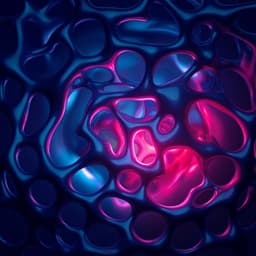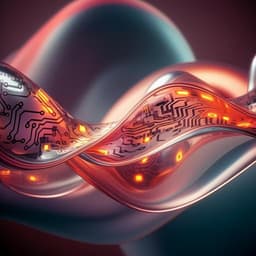
Medicine and Health
Adaptive self-healing electronic epineurium for chronic bidirectional neural interfaces
K. Song, H. Seo, et al.
Discover the groundbreaking adaptive self-healing electronic epineurium (A-SEE) that revolutionizes neural interfaces for peripheral nerve disorders. This innovative technology, developed by Kang-Il Song and colleagues, promises to enhance the integration of electronic medicine with the human nervous system while minimizing surgical complexities.
Playback language: English
Introduction
A peripheral nerve-electronics interface capable of restoring bidirectional communication system in injured nerves can enable reliable control of prosthetic robots and diagnosis and therapy of neurological disorders. The safest and most reliable way to chronically interact with peripheral nerves may be accomplished by combining the following: (i) matching the mechanical moduli of the nerve tissue and electronics, (ii) ensuring strain-insensitive ionic/electronic conductivity, (iii) using biocompatible interfacing materials, and (iv) using a low-invasiveness procedure. Peripheral nerve cuff electrodes were developed for neuroprosthetic applications in human studies. Specifically, spiral cuffs and flat interface nerve electrodes were shown their effectiveness of nerve function restoration achieved by electrical stimulation. The recording of sensory compound action potentials (CAPs) was also achieved by the spiral cuffs and utilized to demonstrate foot drop correction. However, a continuous compressive force exerted to the peripheral nerves wrapped by the cuffs may lead to the deformation of fascicles and blockage of interfascicular blood vessels, which limits the effective recovery of sensory and motor functions after the nerve repair. Although flexible cuff electrodes have shown their stability and effectiveness in both preclinical and clinical applications by alleviating nerve compression in the early stages of implantation, shear forces originating from the mechanical modulus mismatch at the electronics-nerve interface can cause severe immune responses that are accompanied by fibrotic tissue formation. Critical issues may then arise such scar tissue aggravating the peripheral nerve compression caused by the electronic material. This compression induced scar tissue leads to disconnected ionic pathways between the fasciculus and electronic materials, resulting in measurement malfunctions.
Soft, stretchable electronic materials have attracted much attention as a promising neural platform owing to the following advantages: (i) their mechanical modulus can be manipulated to match that of the target nerve tissues to prevent undesirable compressions, and (ii) their electronic performances can be maintained over a wide range of compressive and tensile strains. These advantages have revolutionized intimate neural interface technologies that can be applied to diverse organs in the central and peripheral nervous systems. However, achieving stable interfaces of the bioelectronic devices with the peripheral nerves is still challenging due to mechanically dynamic environment of peripheral nerves induced by repetitive movement of joints and the surrounding muscles. Recently, Bao et al. reported the fabrication of an intrinsically stretchable hydrogel-based conductor with low interfacial modulus and impedance for reliable neuromodulation, which showed the importance of achieving a mechanical modulus match. This strategy is expected to improve the chronic neural recording capabilities of nerve cuffs. However, it should be accompanied by a complete understanding of how continuous deformation and growth of peripheral nerves over long timescales impact environments ranging from interstitial/extracellular to epineurium-electronics interfaces. Although a recent report showed that strain-induced stress relaxation of the extracellular matrix is highly relevant to biochemical signaling at cellular levels, study for achieving the stress-free peripheral neural interfaces in vivo is still insufficient.
Here, we report a new material strategy for the fabrication of an adaptive, self-healing electronic epineurium (A-SEE) for chronic bidirectional neural interfaces.
Literature Review
The introduction section extensively reviews existing literature on peripheral nerve cuff electrodes and their limitations. It highlights the challenges of chronic neural interfacing due to nerve compression and immune responses caused by mechanical mismatch between the implanted electronics and nerve tissue. The authors discuss the advantages of soft, stretchable electronic materials in mitigating these issues, referencing relevant research on hydrogel-based conductors and the importance of achieving a mechanical modulus match between the device and the nerve. The review also touches upon the lack of sufficient research on achieving stress-free peripheral neural interfaces in vivo, setting the stage for the proposed A-SEE.
Methodology
The A-SEE fabrication involved a self-bonding assembly process utilizing a tough, self-healing polymer (SHP) matrix and Ag flake-SHP composite electrodes. The SHP's self-bonding property enabled conformal interfaces with the peripheral nerve without sutures or glue. The SHP matrix efficiently dissipated strain energy, minimizing nerve compression. The Au nanomembrane (AuNM)-Ag flake-SHP composite electrode was fabricated using a transfer printing method, which improved biocompatibility by reducing Ag ion leakage. Various characterization techniques were employed:
* **SEM analysis:** To observe interfaces between the composite and the AuNM.
* **Stress relaxation characterization:** Using dynamic mechanical analysis (DMA) to evaluate stress relaxation properties of SHP, comparing it with PDMS as a control.
* **Electrical characterization:** Four-point probe method for resistance-strain and cyclic stretching/bending tests to assess electrical performance under mechanical stress.
* **Electrochemical characterization:** Electrochemical impedance spectroscopy and cyclic voltammetry (CV) to evaluate impedance stability and stimulation capabilities in PBS.
* **Finite element analysis (FEA):** To model and compare stress distribution on nerve tissue interfaced with PDMS and SHP.
* **In vitro biocompatibility test:** MTS assay to assess cell viability with RAW 264.7 and C2C12 cell lines.
* **Animal preparation and implantation:** Sprague-Dawley rats were used to assess A-SEE's in vivo performance, comparing it to PDMS.
* **Neural signal data acquisition:** CAPs were recorded using a custom-built nerve cuff electrode system and processed with LabVIEW.
* **In vivo neural signal recording:** Neural signals were recorded for 7 weeks during mechanical stimulation with varying intensities.
* **In vivo electrical stimulation:** Biphasic current pulses were used to induce muscle contractions, which were measured with a torque sensor.
* **Nerve-to-nerve interfacing demonstration:** Two A-SEEs were implanted on the ipsilateral and contralateral sciatic nerves in rats to transmit feedback neural signals.
* **Western blot:** To quantify protein levels (GAPDH, CD68, CTGF) in nerve tissue samples.
* **Histology and immunofluorescence analysis:** To examine nerve tissue morphology, immune cell infiltration, and apoptosis.
* **Quantification of Au and Ag-ion leakage:** ICP-MS was used to determine the amount of Ag ions released from the A-SEE.
Key Findings
The A-SEE demonstrated several key advantages:
* **Self-locking and Conformal Interface:** The self-healing property of the SHP enabled self-locking and created a conformal interface with the sciatic nerve without the need for sutures or glue, simplifying the implantation process.
* **Compressive Stress-Free and Strain-Insensitive Performance:** The dynamically crosslinked SHP matrix effectively dissipated strain energy from muscle movement and nerve stretching, reducing nerve compression. DMA and FEA confirmed the superior stress relaxation properties of SHP compared to PDMS.
* **Minimized Immune Responses:** Ex vivo and in vivo studies showed that A-SEE minimized nerve compression-induced immune responses compared to PDMS, as evidenced by lower levels of activated macrophages (CD68) and connective tissue growth factor (CTGF) and less apoptosis (TUNEL assay).
* **Long-Term Neural Recording and Stimulation:** Successful sensory neural signal recording and stimulation were achieved for 14 weeks in a rat sciatic nerve model. The signal-to-noise ratio (SNR) remained stable for 6 weeks.
* **Improved Biocompatibility:** The AuNM coating on the Ag flake-SHP composite reduced Ag ion leakage compared to the bare composite and thus increased biocompatibility.
* **Nerve-to-Nerve Interfacing:** A successful demonstration of peripheral nerve-to-nerve interfacing was performed, showcasing A-SEE's potential for neuroprosthetic applications. The system mimicked the crossed extensor reflex by transmitting sensory signals from one nerve to trigger stimulation in the other nerve, leading to movement of the contralateral limb.
Discussion
This study successfully addressed the critical challenges associated with chronic peripheral nerve interfacing by introducing a novel material strategy based on self-healing and mechanically adaptive polymers. The A-SEE significantly reduced nerve compression and immune responses, leading to long-term stable bidirectional neural recording and stimulation. The study's findings have significant implications for the development of next-generation neuroprosthetics and the treatment of neurological disorders. The successful nerve-to-nerve interfacing demonstration showcases a promising technology for restoring complex neural functions. Although a small amount of Ag leaked from the A-SEE, the results demonstrate the feasibility of this approach for long-term implantation.
Conclusion
The adaptive self-healing electronic epineurium (A-SEE) presents a significant advancement in chronic bidirectional neural interfaces. Its self-locking capabilities, stress-relaxation properties, and biocompatibility enabled stable long-term (14 weeks) neural recording and stimulation. The successful nerve-to-nerve interfacing demonstration highlights its potential for neuroprosthetics. Future research should focus on further minimizing Ag leakage and exploring applications in various neurological disorders in larger animal models and ultimately, human trials.
Limitations
The study primarily used a rat sciatic nerve model. The findings might not fully translate to human peripheral nerves which exhibit different anatomical structures and mechanical properties. While the AuNM coating reduced Ag leakage, complete elimination was not achieved. Longer-term studies in larger animal models are needed to further assess the biocompatibility and long-term stability of the A-SEE.
Related Publications
Explore these studies to deepen your understanding of the subject.







